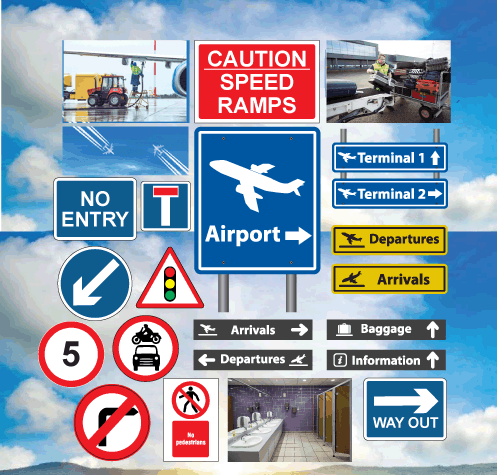
Keeping an airport running is tough. They need to operate safely and smoothly 24 hours a day, balancing flight times, security, and hospitality in one.
As such, finding the right balance between security and speed is essential. Thankfully, airport signs and symbols can help to not only make airports secure but also more efficient.
They may seem small, but proper signage is in every airport. It manages foot traffic, keeps people vigilant and, in rare cases of emergency, can mean the difference between safety and danger.
Below, we list the most important airport signs, common symbols and their meaning. That way, you can understand how traffic signs complement even the most complicated safety procedures.
Airport Terminal Signs, Explained
Airport terminals use a network of regular safety signs and bespoke signage. Usually, you’ll see “normal” signs such as:
- Safety signs
- Notice signs
- Toilet signs
- Transport signs
However, other airport-specific signs exist, particularly around airport security. These bespoke signs describe how to perform each part of the airport security process.
Without these, airport terminals would be chaos. Security is by far the most time-consuming process as airport officials have to get it right. To help with this, they use signs to manage both foot traffic and to explain the security process.
Often, these signs must be multilingual. Usually, the most common languages are supported: English, Mandarin, French, Spanish and Portuguese.
Other specific signs and icons are used, including:
- Arrivals
- Departures
- Immigration
- Baggage transfer
- Oversize luggage
- Customs
- VAT refunds
Overall, these signs don’t support airport safety practices alone. However, they help promote an existing safety policy without effort; they prove that signs can be a powerful force when used supplementary.
Airport Runway Signs, Explained
Ever wondered what all the numbers and signs mean on the runway as you take off? Well, while they’re not directly related to managing the safety of passengers, they do present essential information to airline staff.
In total, there are:
- Centreline Markings: provides alignment guidance for take-off and landing.
- Aiming Point Markings: gives a place for the pilot to “aim” when landing.
- Touchdown Zone Markings: provides distance information for planes and maintenance staff.
- Side Stripe Markings: outline the edges of the runway.
- Shoulder Markings: highlights pavement areas near the runway.
- Threshold Bars: outlines the “beginning” of the runway where landing can take place.
- Threshold Markings: signposts the width of a runway.
- Displaced Threshold: signposts anywhere but the start of a runway, beyond the threshold bar.
- Runway Holding Position: used for taxiing operations.
Enjoy Quality, Versatile Traffic Signs
At Label Source, we stock a range of traffic control management signs for numerous uses. We pride ourselves on producing high-quality, versatile signs and labels.
For everything else, be sure to follow our Twitter for the latest safety news.